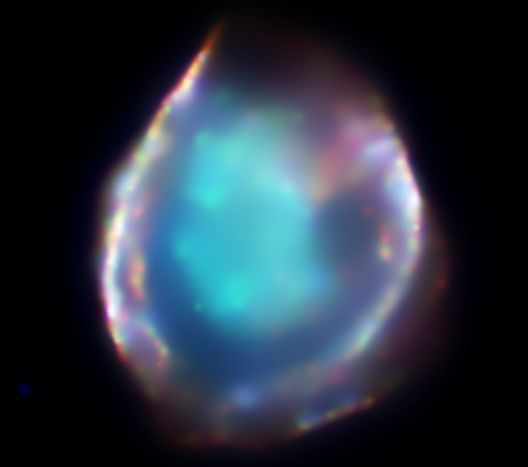Explanation: Large, massive stars end their furious lives in spectacular supernova explosions -- but small, low mass stars may encounter a similar fate. In fact, instead of simply cooling off and quietly fading away, some white dwarf stars in binary star systems are thought to draw enough mass from their companions to become unstable, triggering a nuclear detonation. The resulting standard candle stellar explosion is classified as a Type Ia supernova and perhaps the best example yet of the aftermath is this expanding cloud of shocked stellar debris, DEM L71, in the nearby Large Magellanic Cloud. The sharp false-color x-ray image from the orbiting Chandra Observatory shows the predicted bright edges of the outer blast wave shock region and the x-ray glow of an inner region of reverse shock heated gas. Based on the Chandra data, estimates for the composition and total mass of expanding gas strongly suggest that this is all that remains of a white dwarf star. Light from this small star's self-destructive explosion would have first reached Earth several thousand years ago.
1999 2000 2001 2002 2003 2004 2005 2006 2007 2008 2009 2010 2011 2012 2013 2014 2015 2016 2017 2018 2019 2020 2021 2022 2023 2024 2025 |
Yanvar' Fevral' Mart Aprel' Mai Iyun' Iyul' Avgust Sentyabr' Oktyabr' Noyabr' Dekabr' |
NASA Web Site Statements, Warnings, and Disclaimers
NASA Official: Jay Norris. Specific rights apply.
A service of: LHEA at NASA / GSFC
& Michigan Tech. U.
|
Publikacii s klyuchevymi slovami:
supernova remnant - white dwarf - ostatok Sverhnovoi - belyi karlik - rentgenovskoe izluchenie
Publikacii so slovami: supernova remnant - white dwarf - ostatok Sverhnovoi - belyi karlik - rentgenovskoe izluchenie | |
Sm. takzhe:
Vse publikacii na tu zhe temu >> | |
